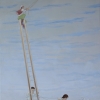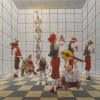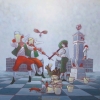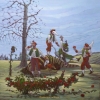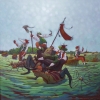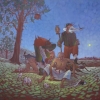Theater Kwibus te IJsselstein werkte enkele jaren geleden aan een productie over het leven van de schilder Jeroen Bosch (1450-1516).
Bij hun oproep aan plaatselijke kunstenaars om zich door hem te laten inspireren is Ans aan het werk getogen.
Zij raakte geboeid door de wijze waarop Bosch zijn visie in het Katholieke Brabant van die tijd omzette in intrigerende schilderijen.
Hiernaast vormen de rondreizende speellieden door het Italië en Europa van de 16e en 17e eeuw, de zogenoemde ‘Commedia Dell ‘Arte’, eveneens een belangrijke inspiratiebron.
Symboliek uit bovengenoemde bronnen koppelt Ans aan elementen van eigentijdse thema’s, zoals actuele gebeurtenissen, dingen van alledag, menselijke zwakheden, de spelende mens.
Er valt veel te zien, Ans daagt de toeschouwer uit om in eerste instantie de eigen herkenning en interpretatie aan te spreken
COMMEDIA DELL’ARTE:
Volkstoneel, opgevoerd door rondreizende spelers met vaste voorgeschreven rollen, die binnen deze toneelvorm gebruikelijk waren.
Er was voor elk van de spelers binnen dit gegeven veel improvisatie-ruimte.
Bij mij gaat het om de baas met 3 knechten.
JEROEN BOSCH:
Van Jeroen heb ik vooral enkele symbolen gebruikt:
– De uil: voor de oude Grieken een symbool van wijsheid; in de middeleeuwen:
voorbode van de dood en transformatie
– Wandelstaf: symboliseert het geloof, dat de mensheid houvast biedt om niet van de goede weg af te raken en wapent tegen bedreigingen; macht
– Munt: iets voor goed aannemen; goedgelovigheid; iemand met gelijke munt
Betalen; munt uit iets slaan
– Vogel: in mijn geval lijkt de vogel het meest op een merel: symbool van betovering
en teken van vrijheid
– Masker: lijkt op een trompe l’oeil. Symbool voor bedrog en verleiding.
EIGEN INBRENG:
– Fantasiefiguur: symbool voor de collectieve onderhuidse gevoelens
– Planten: groei, bloei, vermenigvuldigen, verdringen, etc.
Bijvoorbeeld: Convolvulus arvensis (de akkerwinde, een woekerplant die met haar stengels cultuurplanten omrankt en kan verstikken) en de tuinlieden
– Appel: symbool voor verworvenheden in onze beschaving
– Insecten: hun eigenschappen zijn van wezenlijk belang bij het onderwerp van het schilderij
Bijvoorbeeld:
– Ips typographus (boekdrukker, een schadelijke kever, die zich invreet in fijnsparren en zo de meestal wat oudere pijnbomen uitholt) en de verleiding.
– Opilio parietinus (gewone hooiwagen, een veel voorkomende huis- tuin- en keukenspin) en het bankwezen.
Het schilderij de Hooiwagen van Jeroen Bosch is hier de inspiratiebron voor geweest.
Bijvoorbeeld:
– Procambarus clarkii (rode rivierkreeft, die steeds meer onze wateren bevolkt.
– Emmer: symbool voor water of nuttige kennis uit het onbewuste putten
– Blaasinstrument: het inzetten van de eigen ‘eros’, de universele creatieve levensenergie; het willen beheersen (overheersen) van de situatie. Zoals in de uitdrukking ‘naar iemands pijpen dansen’.
– Telefoon: symbool van communicatie en dus ook: miscommunicatie
Op internet stuitte ik op een artikel, geschreven door Valerie Frissen: ‘De telefoon is geen meneer’.
In de aanhef hiervan: ‘geen communicatiemedium heeft zo’n vanzelfsprekende plaatsin het leven van alledag als de telefoon.
Kennelijk geldt die vanzelfsprekendheid ook voor wetenschappers, want er is geen medium waarnaar zij zo weinig onderzoek hebben gedaan als de telefoon….’
Het gedrag rond het gebruik (en misbruik) van de mobiele telefoon intrigeert mij.
De Latijnse namen staan ook symbool voor de tijd van de ‘commedia dell’arte’, toen deze taal de gangbare spreektaal was in de ‘betere’ kringen.
When Theatre Kwibus in IJsselstein worked on a production about the life of Hiëronymus Bosch (1450-1516), they asked local artists to let themselves be inspired by this Early Netherlandish painter.
Ans set to work. She was touched/captivated by the way in which Bosch translated his view of the Catholic Dutch province of Brabant of the time, into his intriguing paintings.
Ans combines her Bosch-inspired themes with aspects from Commedia dell ‘Arte, troupes of traveling actors and musicians in the 16th and 17th century, playing specific popular characters in Italy and all over Europe. She is fascinated by the grotesque.
She links symbolism from the above-mentioned sources to elements from contemporary themes – current events, everyday life, human weaknesses, playful humans.
There is a lot to see in her paintings. Ans challenges the spectator to call on his own recognition and interpretation. Look in the mirror…
If you’d like to know more about Ans’ meaning behind her chosen symbols, you can read her explanation below.
COMMEDIA DELL’ARTE:
Popular (folk) theatre by a small company of wandering minstrels playing fixed, ‘prescribed’ roles, as was usual in this form of theatre. But within this setting, there was ample room for improvisation, with nudges to current
events – often making the characters into caricatures.
Ans mostly uses the character of ‘the boss’ (Pantalone) and his three servants.
HIËRONYMUS BOSCH
Ans uses some of his symbols:
– The owl: for the ancient Greeks a symbol of wisdom; in the Middle Ages a harbinger of death and transformation
– The walking stick: symbolizes the faith that supports/helps humankind to not stray off the right path; it shields against threats; it also symbolizes power
– The coin: to be gullible; to pay someone ‘in equal measure’; to gain from a situation
– The bird: in her painting(s), the bird mostly looks like a blackbird: symbol of enchantment and freedom
– The mask: looks like a trompe l’oeil: symbol of cheating and temptation
ANS’ OWN SYMBOLS:
– Fantasy figure: symbol for collective subconscious/subsurface feelings
– Plants: growing, flowering, multiplying, repressing/pushing aside, etc.
For example: The apple stands for the achievements in our civilization
Convolvulus arvensis
(the ide, a parasitic plant, whose ranks can entangle and suffocate cultured plants) and the gardeners.
– Insects: their qualities/properties are essential for the theme of the painting
For example:
Ips typographus (a harmful beetle that eats away at, usually older, pinetrees,
eroding them from the inside) and temptation
Opilio parietinus (harvestman, a common housespider) and the banking system
(The painting by Hiëronymus Bosch, called The Harvestman, was the source of inspiration for Ans’ painting)
Procambarus clarkii (the red crayfish, that is increasingly populating our Dutch waters)
– Bucket: symbol for water; drawing useful knowledge from the unconscious
– Wind instrument: to use, bring into play, your own ‘eros’, the creative universal ‘life-energy’; the desire to control (dominate) a situation. Hence the expression ‘dancing to his piping’, or ‘dancing to his tune’
– Telephone: symbolizes communication and, therefore, miscommunication
Ans refers to an article written by Valerie Frissen ‘The telephone is not a sir’.
An excerpt: ‘no other means of communication has such a natural place in everyday life as the telephone. Apparently, scientists feel the same way,
because there is no medium into which they have done so little research as the telephone….’
Ans is intrigued by people’s (mis)behaviour when it comes to using our mobile phones.
The Latin names also refer to the period of the ‘Commedia dell’Arte’ , when Latin was the customary spoken language in the ‘upper class’.

